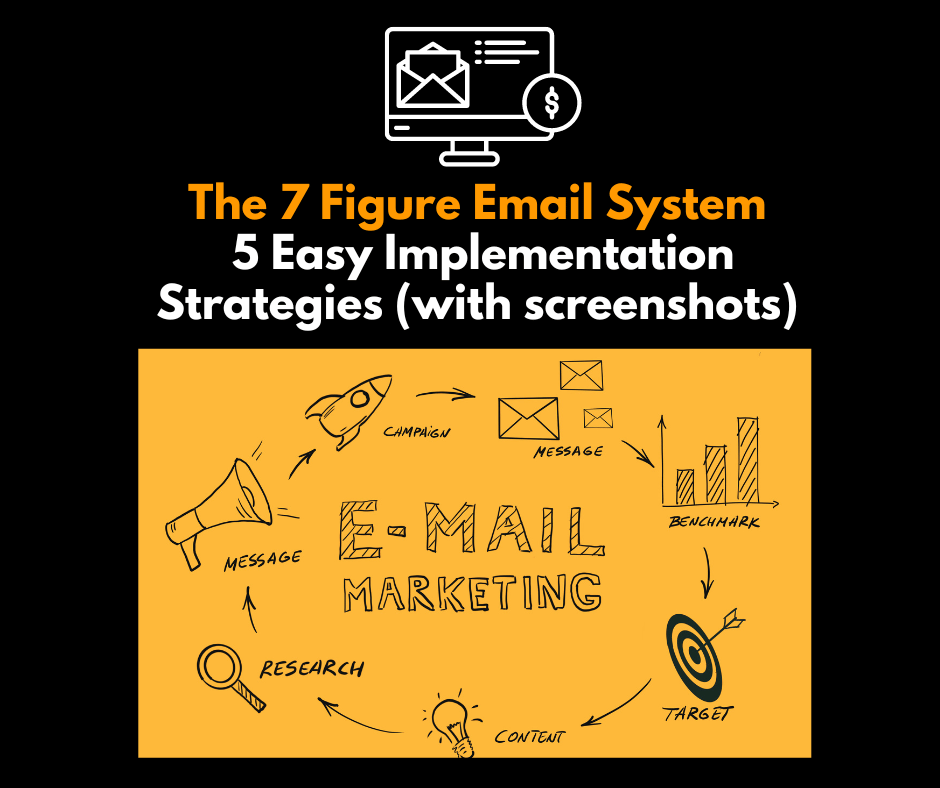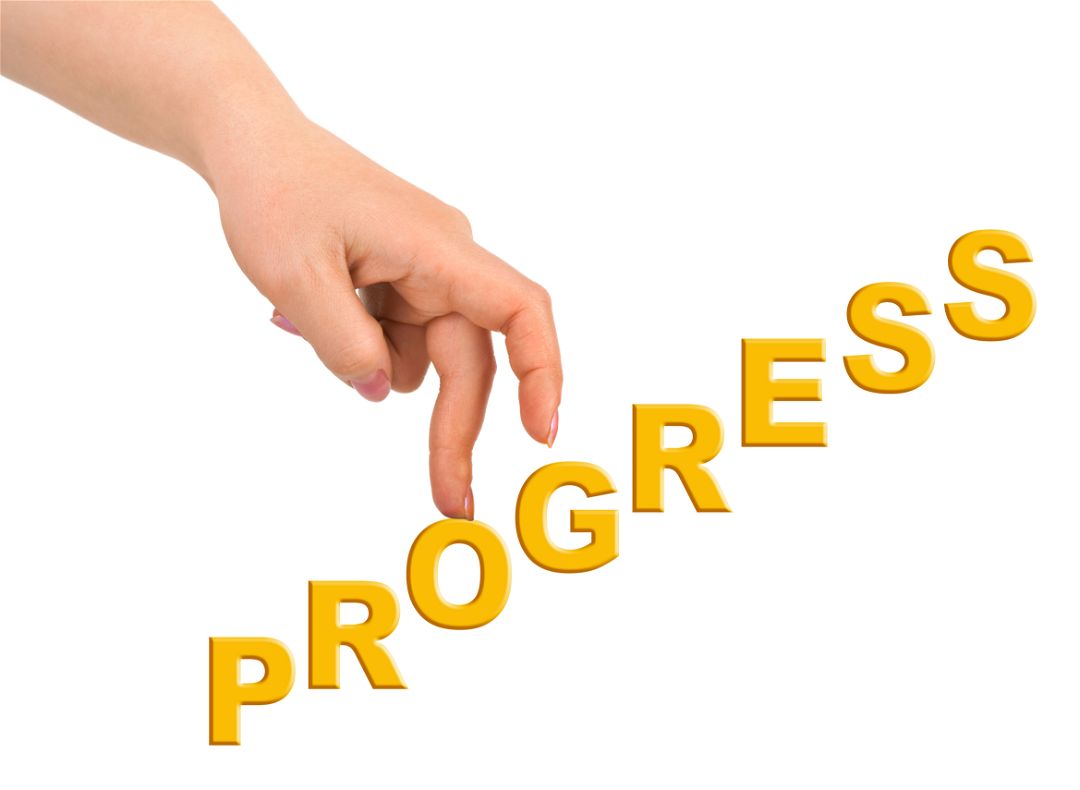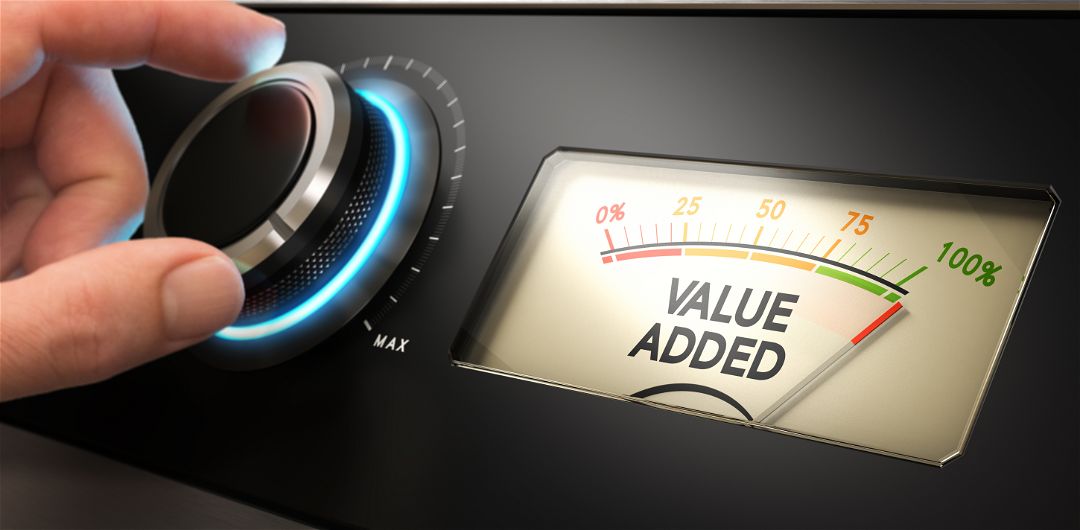7 Figure Email System
Feel you’re underachieving with your email marketing?
Unsatisfied with your results?
Well please read on to discover 5 simple strategies that can make a huge difference to your email performance…


I’m going to show you 5 powerful email frameworks that will rock your email marketing results (4 you can implement this week) and that can exponentially improve your performance…
If you have the feeling that you should be doing more with email marketing, when you just KNOW that you could be doing better, well I have some good news for you.
I’m about to show you exactly what you need to do right now and the simple tools that will help you do it.
In fact, the more esoteric amongst us might say that you’re at this page because you’re supposed to be at this page…
Why I’m Writing This
The truth is… you’re probably being badly advised when it comes to email marketing.
Have you ever heard any of these statements?
- “Email doesn’t work anymore”🙄
- “It’s all about social media”
- “People don’t use email now”
etc….
I’m sure you have, and I have two things to say about this because these comments were either said by someone with:
- A (hidden) agenda e.g. just about to launch a new course on how wonderful social media is and that ‘it’s all you need for your next $ million success story’.
- A lack of knowledge, perhaps inexperienced people ‘faking it till they make it’ who are just regurgitating what they hear elsewhere online and just ASSUME that email doesn’t work.
Spoiler Alert: Oh Yes Email Does Work! And like gangbusters…
I’ve produced a lot of money for people with email and I’ll show you some examples later.
You’re about to learn some really useful email strategies that can genuinely change your business for the better, so grab yourself a drink and get comfy


There are 5 particular things I want to show you that can do right now to exponentially improve your results.
And the good news is that you can start on 4 of them right now and be up and running very quickly.
The other is a tactic based around a seasonal event, so you need to wait till that time of year I’m afraid.
But just these 4 strategies can start generating you significantly more money very quickly, and you could be live this week if you wanted…
⚠ Table Of Contents
1. The 7 Figure Strategic Welcome Series - how $millions are made
2. The 48% Software Advantage - the best way to collect emails on-site
3. The P.E.F. Email Calendar - use this 3-step system to drive maximum sales with minimum input
4. The Lazarus Emails - dealing with the dead names on your list
5. The Piggyback Plan - taking advantage of someone else’s seasonal sale
Short on time? Click here for a PDF download of this post
Why this post is a bit different
I want this post to be not just motivational, but genuinely useful and, unlike some folks out there who are top-liners at best, I’m going to give you the EXACT ‘meat and potatoes’ strategies that I use for each of the 5 insights.
I’m not only going to show you what’s possible but also how to implement it, including the best tools where relevant, so just bear with me and follow along with each step.
What we’ll cover
We’re going to cover a lot of ground here quite quickly, so buckle up for the ride. And you’ll be glad you stayed the course for this one when you discover the simple yet absolutely effective (and potentially game-changing) strategies that I’m going to take you through.
1. I’ll start with the Welcome Series, as it’s such a foundational part of a subscribers relationship with a business.
As soon as someone subscribes to your list, they should be getting a strategic sequence of messages that will help them learn more about you and start to trust you enough to buy from you when the time is right.
2. Opt-in Optimisation is next. Although I have started with the Welcome Series, there is actually a stage before that which is getting people to opt-in to your email list as efficiently and easily as possible – and in high volume too.
Just this part of email marketing on its own is a whole industry inside email marketing, but there is a second tool you should be using which can make this much easier and more successful than a previously has been and i’ll show you what it can do for you.
3. The P.E.F. Email Calendar is absolutely critical to what you do and not just in terms of maximising email revenue. You see this system actually makes it easy to email every day (if you choose to) by minimising the time it takes to get the emails done and ready for broadcast.
And before I forget, P.E.F. stands for Pattern Emotion Frequency.
It’s all about the Pattern and mix of content in the emails and where the product comes in to drive maximum sales.
Emotion is the trigger we use to engage and push people down the path to purchase.
Frequency is not just about how many emails you send it’s also about when and how often to drop the sales messaging into these emails.
4. Lazarus Segmentation is an important part of email marketing and it is particularly important for your delivery – to make sure your emails actually reach your subscribers’ inboxes.
You see if people haven’t opened their emails for a while and, for whatever reason, keep ignoring you, then you need to take action on these ‘dead’ subscribers…and there are two things I am going to suggest that you do.
5. The Piggy Back Plan is a very simple one and in my back simple is always good. It’s about taking advantage of really high market awareness of a particular event and riding on the back of that awareness to maximise your own sales volume.
The first time I did it we got extra sales of $29,000 in 48 hours that would have been lost otherwise.
This is classic ‘found money’ that really helps build in some buffer to hit those tough targets.
Before we go any further – just who is this for?
Well, it will help anyone who wants to do email seriously and maximise their revenue from it, whether you are actively emailing right now or you know you want to.
If you put a gun to my head and said give me some markets, I’d say any kind of expert business or any kind of e-commerce business (physical product sales of any kind) are perfect for email.
But the truth is that email works for any kind of B2B business as well.
If you sell stuff online then email has a role to play.
And one other type of business that I don’t see using email nearly enough is Influencers and other people with big social media followings. These folks are playing a dangerous game and building their houses on other people’s land and absolutely need a backup audience of an email list in case they lose their accounts.
Let’s address the elephant in the room


I also know there will be a lot of people reading this who’ve done a bit of email in the past and then ‘fallen off the wagon’ shall we say.
I know because I’ve been there too, and I hope that makes you feel a bit better if you’re in this camp!
The truth is parts of my email system really came about because of some of the problems that both my clients and myself had in staying consistent with email over the months and years.
One thing I will say is, that like most forms of marketing, email works much better when done consistently.
As well as the pure sales objectives that are a massive part of email, there is also its role in the Relationship System (part two of my three-part master business system approach, fact fans 🙂) as it is the perfect medium to develop those ‘know, like and trust’ factors that are so important in any kind of selling.
And “who consistently emails wins”, as an elite marketing man (who may be called Fraser) once said. 😉
How I grew to love email
I worked for many years in the advertising agency world here in the UK where I mostly bought media space for newspaper and TV ads as well as digital media.
I was very lucky really as I got to see inside some amazing businesses, and also some not-so-amazing ones which might surprise you because that applies to some pretty big companies as well.
But one thing I did see was a common success factor: Businesses that ‘did’ email marketing well, and treated list building seriously, were the same ones who were consistently successful and fastest growing.
And that pattern did not change over the social media glory years at all, despite what you might hear in the press about email being old hat.
During this time I also had many years of frustration seeing people waste so much of that media spend by NOT capturing email data and following up with prospective customers.
I had one client who spent £12 million / $20 million a year at the time and didn’t even have a newsletter or email system of any kind! 😳
We pleaded with them but they thought they knew better, until their site was eventually sold at a knockdown price (like 2% of its previous value) and no longer exists.
It’s sad as they were once the biggest music site in the UK.
But run by idiots frankly…
Now the other really interesting thing about email that I discovered was quite simply the amazing leverage that it gives in terms of results achieved for the effort you put in.
It takes the same effort to send an email to 1,000 people as it does to 100,000 people – and believe me you do get a lot more sales from the 100k list!


And I also saw the amazing lifestyle business that it was for a select amount of people who really had mastered email marketing and had built the nearest thing I have seen to the true ‘4-Hour Work Week’ while earning serious money, but that’s a story for another time…
Some real numbers in $ and £
Now I can tell you all day about how great email marketing is but I always find it better to show you as well, so here are a few examples of what can be achieved with a good plan and a way to pull it off.
“Don’t email too often”, they tell you, “you’ll annoy people”.
If we had not sent an email on the 18th day with our 9th email in that time, then we would not have had our highest revenue day of that whole period, would we?
Goodbye $17,104.07…!


Email broadcasts can make you $000s but email sequences can make you $millions. Literally.
More on this later…but a little more context for you.
Now email is just one part, albeit a crucial one, of The Social List Flow system™, my proprietary formula that I’ve built up over the last few years that truly leverages the best of modern-day marketing opportunities and technology to maximize revenues and results.
It’s an incredibly powerful combination, and email is the core of it.
Side note: I’d be here all day if I talked more about the SLF System too, but I will tell you all the juicy bits about the email marketing strategies that I promised earlier…
So let’s go!
Now let’s get into the real meat of this!
1. The 7 Figure Strategic Welcome Sequence:
I was looking at the stats for a client I was working with for a few years and I pulled out the full year 2021 email numbers recently.
You can see it below.
Just one email from my Welcome Sequence had sales of $175,500, and when you add the others it’s well over $300k.
It’s now done over $1 million in a short period of time.


These sequences run for years. That’s how $millions happen.
Food for thought eh?
That’s a sample of the power of email.
Most people’s ‘Welcome Series’ are too short by the way…but I digress (and not for the first time in this email expose) and more on this later.
Note: you can see my name on the sequence on that bar at the top of the image, so yes it’s really my screenshot and I didn’t just pinch it! 😃
The key to an email Welcome Series or sequence is quite simply in the name – it’s a planned, strategic series of emails that go out in a short space of time, ideally daily, once somebody has opted into your list.
Now just going back to the daily thing for a moment, by chance somebody emailed me with the results of a test they had done on a welcome sequence of their own.
They did an A:B split test of a 4-email Welcome Series over 4 days versus the same 4 emails but dripped over 11 days instead.
And the results were conclusive:
- 50% more clicks in the 4 days 🎉
- 38% more revenue in the 4 days 🎉🎉
Personally I like at least six emails in a welcome sequence, and ideally 10.
I don’t think you can really tell too much about a brand when someone is just discovering you but with one caveat – you must keep it interesting.
Opinion: I don’t think there is such a thing as too long when it comes to marketing communications, but there is definitely too boring, too irrelevant and too selfish.
A marketing friend of mine has written some Welcome Series with over 20 emails in them, and ‘the bigger the better’ is his rule.
Keep it interesting, keep it fun and above all keep it about them and what you can do for them.
Another email truth: There is no one-size-fits-all ‘perfect’ Welcome Sequence.
It depends on too many factors like market and size of range and type of product and the breadth of benefits and their offer hierarchy.
Now there are a few crucial psychological touchpoints that certain parts of a Welcome Series are used to tap into when it comes to relationship building, but nothing is compulsory (except giving them the free thing and not coming over like a dull douche).
Except maybe Email 1.5…🤨 but I digress (and probably not for the first time!).
There are now 19 potential Welcome Series emails in my toolbox that I could use but I may only use 6 of them depending on the market, brand and it’s voice.
For me, the Welcome Series is a constant work in progress, a classic case of ABT (always be testing).


But…it’s amazing how many people don’t have one at all.
Or if they do they just have the 3 email default templates right out of the Klaviyo box (you know who you are!!)
And an E-commerce Welcome Series can be very different from an Expert Brand Welcome Series, so bear that in mind too when you hear about the “perfect” sequence!
Devising a Welcome Series is a very common thing that I work with people on when they book a Voxer Day with me, or some kind of 1 to 1 session, as it can be a task that needs some focused attention.
Sidebar Note: I also have some info products that are off-market right now (but soon to reappear). For example, I have a great set of 11 relationship-building email templates complete with a workbook and instructions, and these can form a significant part of a Welcome series for an expert type of brand.
One last thing – you cannot use AI to write a good Welcome series.
There are too many nuances. There’s too much emotion involved. There’s too much in the way of personal stories and examples needed to make the real authentic you (or your brand) come over properly.
You have been warned! 😉
2. ‘You had me at opt-in’: The 48% Software Advantage
When it comes to email Marketing, everything starts with the opt-in.
No email address = no email marketing!
Now this is a big subject on its own but I’m actually going to make it a fairly short section in this article. And that’s because I’m going to give you one tip to get one piece of software that will almost certainly get you better results than what you’re using right now.
And I already have a much longer review of the software that you can see when you click here.
I’ve used a lot of email systems over the years and I must say that the ‘out of the box’ email system tools such as the forms and pop-ups from providers like ConvertKit and Klaviyo are much better than they used to be, but they are still not as good as some of the specialist tools.
That tool is Convertbox.
It’s a truly effective way to capture more email addresses and convert your visitors through smart, beautifully designed on-site forms and pop ups.
Convertbox uses a combination of advanced targeting and display options along with a gorgeous user interface that, quite simply, gets results.
Here’s a test I did so you can see how well it can perform.
1st set of stats using an email system’s built-in forms = 6.7% optin rate:


2nd set of stats – right after we moved to Convertbox with exact same creative format = 9.93% optin rate:


So the increase in opt-in rate is 48.2% – pretty good eh?
So if you were previously getting 100 opt-ins a day, now you are getting 148 and you don’t need to be a genius to see how that can change your business performance massively and what might be a losing campaign or one that is at break-even can be transformed into a scalable marketing machine.
And that’s just using the most basic of Convertbox Fly-In forms.
You can see 5 more formats here – NB opens in a new window so you don’t forget to come back and read the rest of this 👇👇👇
3. The P.E.F. Email Calendar


As I said earlier, P.E.F. stands for Pattern Emotion Frequency.
Firstly there’s the Pattern of emails. The flow and mix of content, and where best to drop the products in to drive maximum revenue.
There are actually two advantages to you using the pattern part of my PEF Calendar system.
The pattern not only helps you to drive maximum sales but it also helps give you a framework of action to give you the most chance of getting an email out every day.
Probably the number one objection I hear from potential clients and people I am talking with online is that they “don’t know what to write about”.
Now I call them out on that every time and often show them ways around it as, with my systems, there is never a shortage of email copy ideas.
Jeez, just one of my free lead magnets has 50 ideas on its own!
I also have literally hundreds of email templates that my clients can use in my Email Template Vault, which is included in some of my programs.
But even before we get to the templates you might need, you first have to look at the structure of your campaigns, the flow and the mix of content types which make up the Pattern.
Again there is no one size fits all in terms of how this works but knowing the type of email you send each day really makes life easier and makes production and getting them broadcast much more likely.
For e-commerce businesses I saw a few different approaches…


…but most could include these types of emails:
- Monday – News from the Founder (personal story from the business)
- Tuesday – Product / Limited Offer of the week
- Wednesday – ‘New-In-Store’ or Category Focus or some other kind of S.E.P. (stock exploratory piece)
- Thursday – Hot this week (bestsellers / seen on social etc)
- Friday – Weekend specials / markdowns / sale items starting now
- Saturday/Sunday – Product / Limited offer of the week ending (buy now / FOMO etc)
For expert businesses, some of the pattern is similar to the e-commerce laydown above but there are a few differences, as the expert business is typically much more focused on a sector or even a product, and communication style is typically on a more personal level.


- Monday – A motivational email (I have over 300 motivational emails that clients can copy and use as their own in my Email Template Vault)
- Tuesday – a ‘storyselling’ email with a ‘Product of the Week’ promo
- Wednesday – a personal story and glimpse into my working life. I call these ‘founderporn’ 🙂
- Thursday – a deeper dive into my product of the week plus bonus, pulling out the features and benefits in more detail
- Friday – Last call for Product of the Week – closing FOMO is key here
- Saturday/Sunday – Weekly market/industry round-up and soft sell of affiliate product
Of course there are a few more nuances and ‘personalisations’ to really make this fly but I hope that gives you an insight into the higher level pattern planning behind it.
Let’s move on to the E -> Emotion.
Emotion is the first step to selling, even in low-interest B2B type products or industrial products.
Only then do we try and justify purchase decisions with logic.
You’ve probably heard of the Gain-Logic-Fear sequence of selling by email and that’s exactly why it works.
It manipulates the emotions of the right brain but also supplies the left brain with the features and benefits and logical reasons why something is a ‘great buy’.
And storytelling is a huge part of this process.
When you tell an emotional story (and I don’t just mean a tear-jerker) that is related to your world and your products, it makes selling a lot easier.
Again this is a whole industry in itself so no more detail for now.
Frequency is always a hot topic for discussion when it comes to email. it’s very emotive for many people but usually that’s from the people receiving it rather than sending it.
You need to think about things from the viewpoint of the sender – because that’s what you are.
The fact is, the more you email the more you sell.
Precise figures vary from list to list, but if you email 3 times a week you’ll typically sell 3 times more than you will email emailing once a week; and possibly more because people get into a habit of expecting and opening at least some of your emails.
I actually know two marketers who email almost every day of the week and when, on occasion, they don’t email for a few days they literally get people asking them on social media or sending emails to check if they’re OK, and wondering when they’re going to start emailing again!
How nuts is that, eh? But what a great position to be in when people actually MISS and seek out your emails! 🤗
If you want rules then most expert businesses (teachers / coaches / tutors etc) and I include myself in that group, can email most days as long as they add value every day.
This is the key to successful email: you must add value.


But value is not just price or discounting.
Value can be entertainment. It can be the understanding of a reader’s situation. Or it can be adding motivation.
If you’re an expert brand it’s about your world view, and attracting people who think and believe the same kind of things you do.
Much as I dislike the man himself, Donald Trump is a genius at this.
If you’re an e-commerce or physical products brand, the frequency is typically lower and most people I’ve worked with do well on three times a week – but do go up to daily during special sales periods.
However, I do know some e-com brands who email every day and do very well from it.
One in particular is not even a very big brand; they don’t have a big product range but they are one of the best I’ve ever seen.
Sidenote: I’ve actually collected their emails for the last couple of years in a swipe file that I use with some clients. I may release it in the future or use it in my email program so keep an eye on the availability of that if that’s something that interests you.
And as you can probably see from what we’ve looked at so far, this system actually makes it easy to email every day (if you choose to) by minimising the time it takes to get the emails done and ready for broadcast.
As always strategy is the real superpower here.
4. The Lazarus Email


As you might have guessed this one is about reinvigorating the unresponsive deadwood weighing down your list.
How could they ignore me I hear you say?
I have so much wonderful knowledge, almost mystical insight and fabulous deals to bring to the world. 😂
Well the reality is that a whole bunch of people just never open your emails, and this can be between 5% and 50% 😲 in my experience.
And this depends on so many factors that I can’t give you a formula for it.
It’s just another email truth, but one that you have to be aware of and have a plan for dealing with…
But it is helped by adding Email 1.5 to your Welcome Series as well as placing some other strategic triggers in your welcome sequence.
But I digress once again…🤦♂️😆
Rule Number 1 of email club: Never email your whole list at the same time in one broadcast.
The reality is, on any reasonably mature list, a whole bunch of names have become unengaged and are dragging your email account quality down.
Right now I’m going to cover two of the things that you can do to maximise results from these unwashed, sorry, unengaged subscribers.
The first one is to send them a Sunset Sequence.
If you’re doing all the right things like sending a Winback sequence, and still have a bunch of email subscribers that haven’t engaged with you…it may be time to “let the sun go down” on these subscribers, perhaps while channelling a bit of Elton John as you do it by sending a Sunset Sequence.
The usual trigger for a Sunset Flow is engagement, or really clicks in this post-iOS 15 world we live in where opens are hard to measure.
If someone hasn’t engaged for a while – could be 90 days for a daily emailer or 180+ days for a weekly emailer – then it’s ‘last chance saloon’ time for these subscribers.
The Sunset Sequence is often portrayed as a bit of a parody of a broken-down relationship.
I have seen emails with “Are we breaking up?” or “Is it really time to say goodbye?” type subject lines.
It gives subscribers one, or more often, two final opportunities to stay on your list.
Side Note: any more than two emails can hurt your deliverability.
It is a simple message: “If you don’t take action and click a link, this will be the last email you get”. Or you can also request a reply and ask them if you have “done something wrong” or “have we upset you?”.
Keep it simple and personal: Plain text emails from “real people” tend to work well.
CTA should promote engagement: “If you want to stay on the list, click here” or “What do you want more of? Respond and let us know” (the latter also improves deliverability).
Clear unsubscribe/manage preference links: Allow them to update their settings manually rather than be removed from your list.
Pro Tip: remember to segment these re-engagers.
Once they’ve engaged again, they should be automatically removed from the Sunset Sequence and put back into the engaged segment.
As well as a Sunset Sequence, there is another type of email that I have used successfully to reactivate large numbers of dead, sorry unengaged, subscribers on a list.


I call it the Hyper Personal Curiosity email and it is based on a format I originally learned from Troy Ericson (thanks Troy!).
I won’t spill the beans on Troy’s method too much, though I have changed it a fair bit too for my own needs, but the premise is that you make the email appear more like a personal 1 to 1 email rather than a corporate email.
And, once inside, the body copy is deliberately coy and uses some blind copy referring to ‘something very special’ that will be revealed by clicking the link.
I do think it is the subject line that is the real secret weapon but I can’t disclose that here in the open out of respect for Troy’s IP. I hope you can understand that.
The upshot is that this type of email has been very successful for me at re-engaging people.
The main objective is to get opens and clicks from this email – any sales are a bonus.
This is a list that you have probably spent money building and these subscribers had an interest in your market or product at one point when they signed up, so it makes sense to pull out all the stops to keep them interested for a bit longer at least.
I had a client with a big list that hadn’t been particularly well managed, and they had a lot of unengaged that met the criteria we put in place.
So I set up my Hyper Personal Curiosity email and in the UK list alone we recovered nearly 8,000 people who had become unengaged and put them back into the engaged segment.
You can see the stats below – bonus proof points for spotting my initials on the campaign name again! 😎😁


5. Piggy Back Plan
The Piggy Back Plan is, as I said, a very simple but very effective seasonal promotion.
A relatively new phenomenon in recent years has been Amazon Prime Day (now actually a 48 hour sale) where Prime subscribers get a bunch of great offers as a perk of being in the Prime program, while also encouraging non-subscribers to join to access these fab deals.
And it’s the deals and offers that are the main point here because it’s a massive event now and you’d have to be living under a rock not to be aware of Prime Day.


But there’s also a way that we can capitalise on this deal fever…
…And that’s to launch our own prime day piggy back deal!
People are Primed (sorry!) and looking for deals…which we will give them.
They’re often actually waiting for emails about when it starts and when the first deals are available as it’s ‘first come first served’ for the limited items.
If ever there was a time for you to email with a price offer…it’s now!
Plus it’s a classic “reason why” to have a sale. It makes sense to the consumer when they see you offering a deal too so there’s less scepticism about the offer too.
And what I have done each year is keep it very simple.
Here are two sample subject lines from a previous campaign:




One early on Day 1 and then a reminder of the deal closing on Day 2.
And you can do more if you want to, such as ‘6 Hours To Go’, ‘Last Hour’ etc if you really want to crank it up.
As I said these two emails brought in a nice windfall of $29,000 extra in sales in the 48 hour period the first time we tried it.
That’s not to be sneezed at for most businesses.
Here’s a snapshot of a section of the email:
—————————————————-


——————————————————
As you can see there is no black magic here.
It’s not even a suicide offer or loss leader.
At 20% off it still offers enough margin that is more than made up for by the volume.
And of course, you can always make the offer specific to certain products or categories, such as end-of-season or overstock items that need to be moved on.
Overall it’s a simple yet strategic offer – well timed and well priced and with a reason for it to start and end when it does.
It’s only 48 hours because Prime Day(s!) only lasts 48 hours and you will miss out if you don’t act now.
We also used a special kind of Countdown Timer to drive the FOMO higher too and that can be very effective in this kind of situation, but use these wisely young Jedi… 😉
I’ve spilled the beans and served up 5 courses of email marketing goodness for your pleasure.
“And now I’m spent“ as Austin Powers once said.
As I have demonstrated, email is incredibly powerful when used to its potential. And i’ve always believed it sells exponentially more than social media.
Seems i’m not alone.
James Clear is the author of the bestseller ‘Atomic Habits’, which covers easy and proven ways to build good habits and break bad ones. His book has sold more than 10 million copies since its release and its stats are mindblowing – e.g. on average Atomic Habits has sold one copy every 15 seconds since it was published!
James also has one of the most popular email newsletters in the world with another mind-blowing stat: more than 2 million subscribers! 😲


In other words, James values email subscribers 25-50 x times more than social media followers.
This is one smart dude who knows the value of email marketing.
And another take out of this is how a successful book really is the ultimate lead magnet, assuming the author is smart enough to have a way of getting people onto his list via an incentive inside the book.
I mean a 2 million list is just insane! What an incredible asset.
I’d maybe even sell my first born child for that (sorry Grace!) 🤣
TL:DR Time
For the short on time or very impatient amongst us 😉 here’s the TL:DR (Too Long Didn’t Read) summary.
If you want to make a real difference to your email results then I have 5 real world actions you can take to really rock your email results fast.
- The 7 Figure Strategic Welcome Series – this is how $millions are made in a very hands-off manner. Set this up, optimise it, make it longer than it currently is and you will make more sales.
- The 48% Software Advantage – is a piece of low cost software that is the best way to collect emails on-site. My testing has shown its power many times and it is a flexible yet powerful tool that generates grat looking optin forms and boxes in a variety of formats and roles.
- The P.E.F. Email Calendar – use this 3 step system (Pattern Emotion Frequency) helps to drive maximum sales yet also makes more frequent emailing actually achievable for your business. There are certain patterns and formats I recommend and it depends on your type of business but the more you mail, the more you make.
- The Lazarus Emails – dealing with the ‘dead’ names on your list is a smart strategy, because if you ignore them or keep mailing them it will harm your deliverability and waste money. There are two complementary strategies you can use to rengage the most subscribers you can before deleting them for good.
- The Piggyback Plan – take advantage of Amazon Prime Day with your own price offer and take advantage of people literally waiting for deal news on the day. A couple of simple emails could net you $000’s in revenue.
Note: If you’re too busy to go back to the detail right now and you’d like a PDF copy of this post for future reading, then please click here.
It takes two baby…
You have two things now – knowledge and options.
You can take the learnings I’ve given you above, put them into action and quickly add 20% to your email sales in a month.
I’m pretty confident you can do that if you’re already up and trading and currently have a live list of some form.
You’d probably reach that solely by implementing Convertbox and getting 40%+ more opt-ins for your list!
And if you’re less experienced in email marketing then you are in a great position too – you can cut down your learning curve massively by getting some crucial basics in place that will give you a great foundation for super fast growth. 📈
Assistance is available
Now you may not want to implement it yourself, or you’d like some additional training to really make things fly, so perhaps I can help a bit further.
I have a new Email Deep Dive program packed with templates for the DIYers, and I have a range of Consulting, DFY or ‘Done With You’ options for those wanting a bit more ‘hands-on’ support.
Get in touch for more details.
I reckon I can help in most situations (and, if not, I know someone who can).
I think I do good work, and some other people are kind enough to say so too…
Here’s what Gwen said about one of my courses:
“I have been working my way through the email course… WOW! What gold nuggets indeed! So much in there, it’s incredible.”
Gwen Baird
Founder of Tweet Like A Pro Twitter Academy at RAG Social
But, outside of training, it’s important to know that the people you work with can deliver, and do so consistently, and hopefully some of the examples so far have shown that.
You might say talk is cheap, demonstration is more valuable.
And 3rd party praise is like hard currency in my world 🙂 so here’s another.
There was a food business that I pretty much single-handedly saved from going under, and part of the journey involved me building an email list of nearly 25,000 in just six months.
As you can imagine the owner did say some nice things about me…
“Fraser’s involvement in building and developing the strategy and execution of Mud’s expansion into online was instrumental to the success that the brand now enjoys. Expert stewardship, insightful, plain speaking and a laser-targeted approach to digital marketing, Fraser’s dedication and professionalism has been exemplary at every step of the journey.”
– Christian Barrington, Founder of Mud Foods.
Like what you’ve seen? Think I might be able to help?
Well just get in touch.
Go to the contact page at https://fraserneilson.com/#contact or message me on social.
We can book some time in my diary if you want to discuss this further.
We can do a lot in 15 minutes.
Your promise to me…
Yes I know it’s usually the other way round, but bear with…
You see it’s time to come clean.
There is a catch – I want something from YOU.
I want a promise from you.
You likely spent a chunk of time reading this and I want you to get an ROI on that time invested with me.
I need you to start doing email ‘right’.
Do it properly, strategically, consistently. With a bit of love even. ❤️
And, if you do that, I promise you that a few months down the line you’ll be in a much better marketing place than you are now.
You’ll likely be a bigger, better, safer business with the growing asset of an email list that performs consistently well for you.
I’d love you to be my next email success story and so, if you do take this and run with it, I’d love to know how you get on. So again please contact me.
